Preserve your bounty of fresh peppers for year-round cooking by following tried and true home preservation methods. Canning, freezing or dehydrating -- each technique has its benefits and its drawbacks. No matter how you choose to preserve peppers, be sure to follow food safety measures to avoid ending up with peppers that can cause botulism or other forms of food poisoning.
Freezing Peppers
Because peppers are one of the few vegetables that don't need to be blanched -- boiled briefly before being plunged into ice water -- before freezing, preserving them in the freezer is one of the simplest techniques. Frozen peppers typically aren't as crisp after being thawed, making them best for use in cooked dishes that don't rely on the texture. Peppers can be stored in the freezer for approximately nine months.
- Wash fresh bell peppers, and then slice or dice them into the size you desire and arrange them on a baking sheet. Freeze them for 1 to 2 hours before transferring the peppers to airtight containers or resealable freezer bags, and storing them in the freezer.
- Remove the seeds and stems from roasted peppers before slicing, dicing or flattening them whole. Pack the peppers in airtight containers with waxed paper between whole peppers or layers of cut pieces.
Canning Method
You don't need much equipment to can fresh peppers, but you do need clean canning jars and a pressure canner. Because the skin turns tough and leathery after canning, remove pepper skin for the best results.
Sterilize the canning jars in the dishwasher.
Place a pot of water on to boil.
Blister the skins of the peppers in a dry pan heated on the stove, under the broiler, in an oven set to 400 degrees Fahrenheit or on the grill. Let the peppers cool before rubbing the skin off.
Once the peppers are peeled and prepared, start filling your canning jars loosely, with approximately 1 inch of space at the top of each jar.
Carefully pour the boiling water over the peppers, using enough to submerge the peppers, but still leaving 1 inch at the top of the jar.
Put the rings and lids on. Transfer the jars to a pressure canner filled with 4 inches of water.
Heat the canner on high and let the steam vent for 10 minutes before adding the weight, building the pressure to 11 pounds and processing the jars for 35 minutes.
Pickling Peppers
Pickling peppers gives them enough acidity to safely can using a water bath instead of a pressure canner. Because this method requires lower temperatures, the peppers retain a pleasant crispness. To pickle peppers, sterilize canning jars in the dishwasher and fill them with sliced or diced peppers, leaving 1/2 inch of space at the top of each jar. Add brine ingredients such as pickling salt and good quality vinegar, and pickling spices such as bay leaves or garlic to a pot.
Bring the pickling liquid to a boil and pour it over the peppers, fully covering them and leaving 1/2 inch of headspace. Run a knife around the inside of each jar to get rid of any air bubbles. Place the rings and lids on the jars, and process them in a large pot of boiling water for 10 to 20 minutes, depending on your altitude.
Drying Peppers
Drying -- or dehydrating -- removes the moisture in the peppers, which prevents mold, yeasts and bacteria from growing. Just as blanching isn't necessary to freeze peppers, it also isn't required before you dry them. Remove the seeds, membranes and stems. Slice or chop the peppers, and arrange them in a single layer. Methods for drying peppers at home include:
- Dehydrating in a dehydrator set to 140 degrees Fahrenheit for 8 to 12 hours.
- Drying the peppers in an oven set to 140 F, or as low as the oven goes. If your oven temperature doesn't go as low as 140 F, expect the peppers to dry faster.
Check the peppers every one to two hours during the drying process. When the peppers are fully dried, they should be brittle. Store the dehydrated peppers in a cool, dark spot, and in airtight containers for one to two months at room temperature, or six to 12 months in the refrigerator.
Related Articles

How to Preserve Pimentos
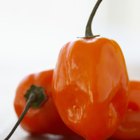
How to Roast & Freeze Habanero and ...

How to Pickle Peppers in Small Batches

How to Freeze Cherry Peppers
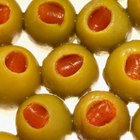
How to Cook Pimentos

How to Store Hot Peppers
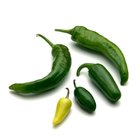
How to Dry Jalapenos
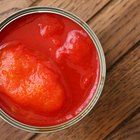
How to Preserve Salsa Made With Canned ...
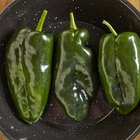
How to Broil Poblano Peppers in the Oven
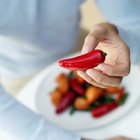
How to Freeze Cayenne Pepper
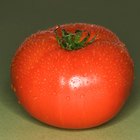
How to Blanch, Peel, & Freeze Whole ...
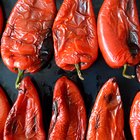
How Many Calories Are in Roasted Red ...
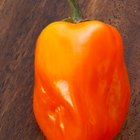
How to Grind Habanero Peppers
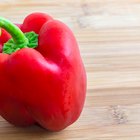
How to Dry Red Bell Peppers to Make ...
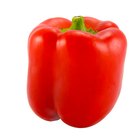
How to Preserve Roasted Red Peppers
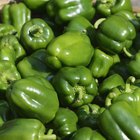
How Do I Blanch Green Peppers?

How to Get Skins Off Peppers
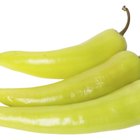
How to Brine Banana Peppers

Facts About the Jalapeno Pepper

How to Prepare Hungarian Wax Peppers
References
Writer Bio
Caryn Anderson combines extensive behind-the-scenes writing experience with her passion for all things food, fashion, garden and travel. Bitten by the travel bug at the age of 15 after a trip to Europe, Anderson fostered her love of style and fashion while living in New York City and earning her degree at New York University.